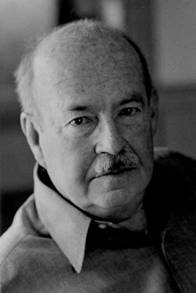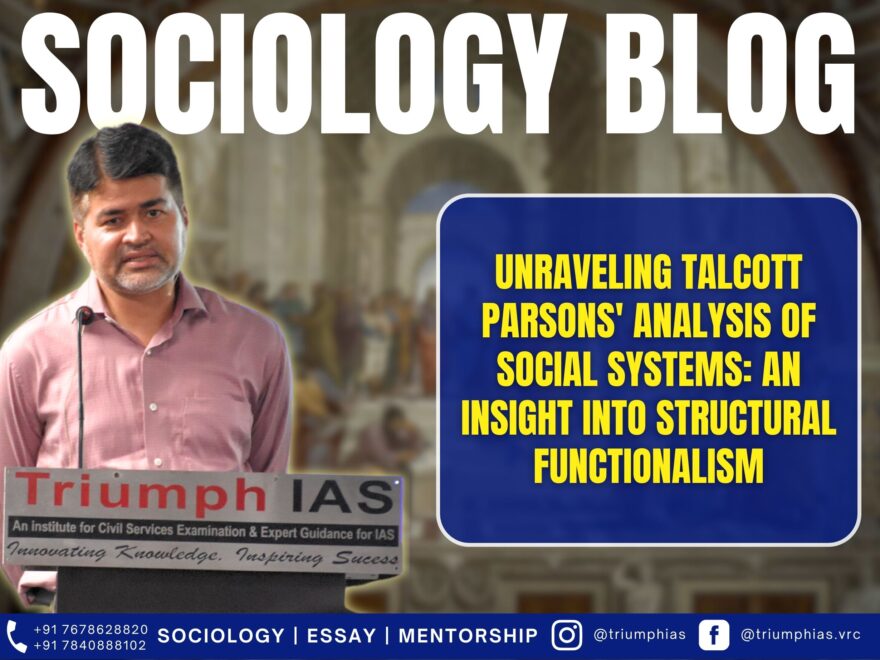
Sociology should… be thought of as a science of action-of the ultimate common value element in its relations to the other elements of action.
Social Systems
Relevant for Sociology Paper-1 (Unit-4)
In Talcott Parsons conceptual framework, the notion of a system holds significant importance. It serves as a broad and abstract term that encompasses a range of phenomena, spanning from a simple dialogue between two individuals to the complex network of nation-states on a global scale. This concept forms the foundation of Parsons’ comprehensive analysis.
Systems
A system maintains a distinct identity within its surrounding environment, signifying its openness. Take, for instance, a living organism like a mouse, which operates as an open system. The mouse exists separately from its environment, yet it must interact with it by taking in essential resources (such as air and food) and expelling waste products. The fundamental objective of a system is to preserve its own identity while navigating the challenges posed by the environment. This involves two key aspects:
- Regulating interactions with the environment.
- Sustaining effective internal relations within the system.
Building upon these foundational principles, Parsons endeavored to present a comprehensive analysis of how social systems function. Following the publication of his books in 1951, Parsons found a fresh approach to developing his analysis, largely influenced by his collaboration with Robert F. Bales, a social psychologist who aimed to create a general model for understanding the behavior of task-oriented small groups.
Individuals come together to gather the necessary resources for a specific task. Once assembled, they coordinate their efforts to accomplish the task at hand. In this process, they handle their internal dynamics, such as resolving conflicts and maintaining engagement. After successfully completing the task, they take a break and engage in activities unrelated to the task before regrouping for the next assignment.
Parsons developed the four-phase model of system exchanges, which he further elaborated and applied to various contexts. This model became a central focus of his subsequent work.
Talcott Parsons, a prominent figure in structural functionalism, made significant contributions to the field. At the core of Parsons’s theory lies the AGIL system, consisting of four functional imperatives. According to him, all systems, whether it be the family, the economy, or the polity, establish boundaries to sustain themselves. This self-maintenance is made possible by the socialization of individuals in society, which shapes their motivational and value orientations. To ensure their survival, social systems must establish crucial adjustments between their internal organization and the external environment.
Parsons argues that social systems possess inherent mechanisms for self-adjustment and self-preservation. These adjustment processes, which uphold the internal functioning of the system and its relationship with the surrounding conditions, are referred to as functions. Functions represent the system’s means of self-maintenance.
Talcott Parsons identified specific functions that are essential for the survival of a social system. He referred to these functions as “functional prerequisites.”
- Adaptation,
- Goal attainment,
- Integration
- Parsons developed a model of system exchanges that consists of four functional prerequisites. These prerequisites are crucial for the functioning of a social system and can be categorized based on their relationship to the system’s internal or external processes. They can also be classified as either consummatory or instrumental in nature.
- The first functional prerequisite is adaptation, which involves acquiring and utilizing resources from the external environment to sustain the system. For instance, the economic system relies on resource utilization, production, and distribution within society. Adaptation is instrumental in nature and focuses on factors external to the system.
- The second prerequisite is goal attainment, which entails setting goals, motivating system members to achieve those goals, and mobilizing their efforts. Goal attainment is consummatory in character, although it involves some external interaction. Political processes and the organization of power and authority exemplify this prerequisite.
- Integration is the third functional prerequisite, responsible for maintaining coherence, solidarity, and coordination within the system. Culture and values play a significant role in performing this function. Integration ensures system continuity, coordination, and solidarity, protecting it from breakdown or disruption. Integration is internal to the system and has a consummatory nature.
- The fourth prerequisite is latency, which involves storing, organizing, and maintaining the motivational energy of system elements. It focuses on pattern maintenance and tension management within the system. The socialization process of system members fulfills this function. Latency is essential for maintaining stability and managing tensions within the system.
- In a complex system, different parts may specialize in specific functional phases, with each part prioritizing certain activities on behalf of the entire system. Parsons emphasized that the concept of a system depends on the purpose of analysis, whether it considers the system as a whole or its subsystems and sub-subsystems. Furthermore, sub-systems may engage in multiple functions to meet their own specific requirements.
- Parsons later explored the interchanges between functionally differentiated phases within the system. He recognized the need for balanced exchanges between the adaptive phase and the goal attainment phase, as resources from the adaptive phase must be transferred to support the activities of goal attainment. Similarly, the government fulfills the goal-attainment function for society, and in return, the adaptive system must provide resources to sustain the government.
- Overall, Parsons’s model of system exchanges provides insights into the functioning and interdependencies of social systems, highlighting the importance of maintaining balanced relationships between their various functional prerequisites.
- Parsons’s framework offers a nuanced understanding of system dynamics, allowing for intricate analyses. It can be further developed by examining the patterns of interaction and exchange between the different phases, such as the interface between the I (Integration) and L (Latency) phases, which also require certain resources. Additionally, exploring the nested nature of these exchange patterns reveals the hierarchy of sub-systems and their relationships with the encompassing system, along with their own internal exchanges.
- The application of the AGIL model extends from interpersonal interactions to societal levels, encompassing various complexities. Elaborating on these patterns requires a sophisticated and multifaceted approach.
- Supplementing this model are four action systems, each serving a functional imperative: the behavioral organism fulfills the adaptive function, the personality system serves goal attainment, the social system performs integration, and the cultural system maintains patterns. Parsons observed these action systems operating at different levels of analysis, starting from the behavioral organism and progressing to the cultural system. He viewed these levels as hierarchical, with each level being influenced by and controlling the levels below it.
- Parsons primarily focused on the establishment of social order, basing his theory on several assumptions. He recognized the interdependence of systems, their tendency toward equilibrium, the potential for static or changing states, the significance of allocation and integration at equilibrium points, and the self-maintaining nature of systems. These assumptions guided his emphasis on order while somewhat overlooking the aspect of change.
Parsons categorizes pattern variables to illustrate the main types of social structure clustering, consisting of four distinct types.
- The Universalistic-Achievement Pattern: This social structure promotes achievement based on legal and rational methods. It is prevalent in modern industrial societies that prioritize values such as equality, democracy, freedom of enterprise, rational management, and open social interaction. Divisions based on caste or ethnicity are not compatible with this system. An example of this pattern can be observed in American society.
- The Universalistic-Ascription Pattern: In this configuration, roles are performed with an emphasis on legal rationality, but the distribution of authority is not based on equality or democracy. Modern principles of science and technology are applied in industries and communication, but the distribution is determined by ascriptive principles, such as membership in ideological associations, parties, or cults. Nazi Germany serves as an example of this type of society, according to Parsons.
- The Particularistic-Achievement Pattern: This society is characterized by the dominance of “familism,” which encompasses continuity with ancestors and strong kinship ties, while also emphasizing achievement and adherence to a code of propriety equivalent to legal rationality. Classical Chinese society, influenced by Confucianism as its official ethic, exemplifies this structure. The recruitment of government servants in China, who predominantly belong to the Communist Party of China, showcases the coexistence of universalism and ascription principles.
- The Particularistic-Ascription Pattern: This type of social structure organizes roles based on values associated with kinship, birth, and other ascriptive factors. Individual achievement through personal effort is not encouraged, and work is seen as a necessary evil. Traditionalism prevails, with an overwhelming emphasis on expressive or artistic orientations. Spanish Americans in the United States exemplify this social structure.

Analysis
- Parsons rejected the early approaches to studying social systems, including utilitarian, positivist, and idealist perspectives. He found shortcomings in these approaches, such as an excessive focus on external motivations in utilitarianism, a lack of consideration for errors and values in positivism, and an overemphasis on values in idealism. In response, Parsons developed his own integrative theory known as the “action approach.” This theory incorporates both motivational and value orientations.
- According to Parsons, roles play a crucial role in social systems. When individuals perform their roles, they face dilemmas arising from the choices presented by society in terms of motivational and value orientations. Parsons describes these orientations through his pattern variables, which determine the actions individuals take in society.
- Furthermore, Parsons identifies certain functional prerequisites that are essential for the existence of a social system. These prerequisites include adaptation, goal attainment, integration, and latency. Without these functions, a social system cannot sustain itself. Parsons also provides examples of different types of social systems based on criteria such as universalism, particularism, ascription, and achievement, drawing from real societies.
To master these intricacies and fare well in the Sociology Optional Syllabus, aspiring sociologists might benefit from guidance by the Best Sociology Optional Teacher and participation in the Best Sociology Optional Coaching. These avenues provide comprehensive assistance, ensuring a solid understanding of sociology’s diverse methodologies and techniques. Sociology, Social theory, Best Sociology Optional Teacher, Best Sociology Optional Coaching, Sociology Optional Syllabus.
Talcott Parsons, social systems, system exchanges, functional prerequisites, adaptation, goal attainment, integration, latency, structural functionalism, pattern variables, universalistic-achievement pattern, universalistic-ascription pattern, particularistic-achievement pattern, particularistic-ascription pattern
Follow us :


https://t.me/VikashRanjanSociology
Find More Blogs
|
Scope of the subject and comparison with other social sciences |
|||
|
|
|
|
Modernity and social changes in Europe |

